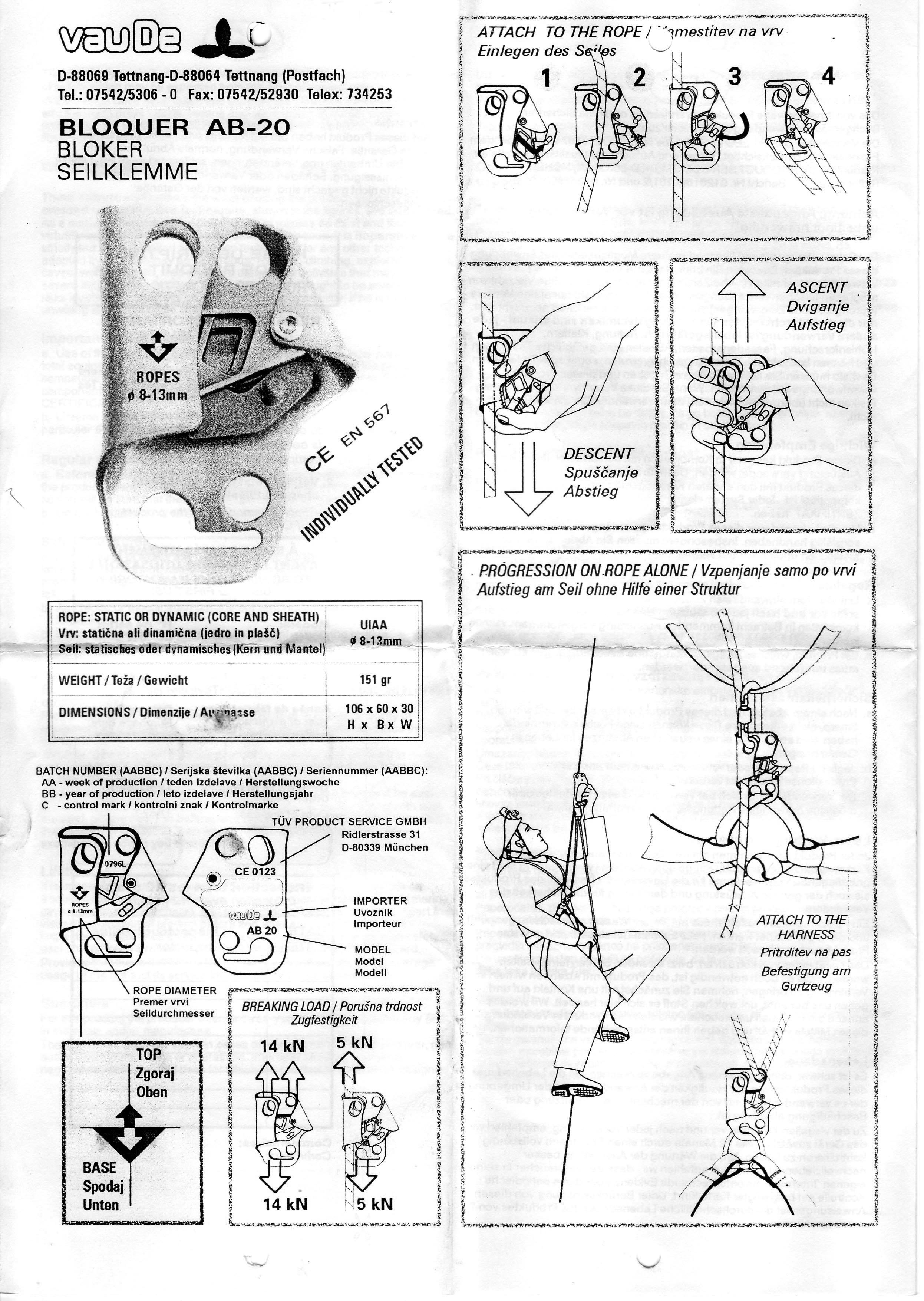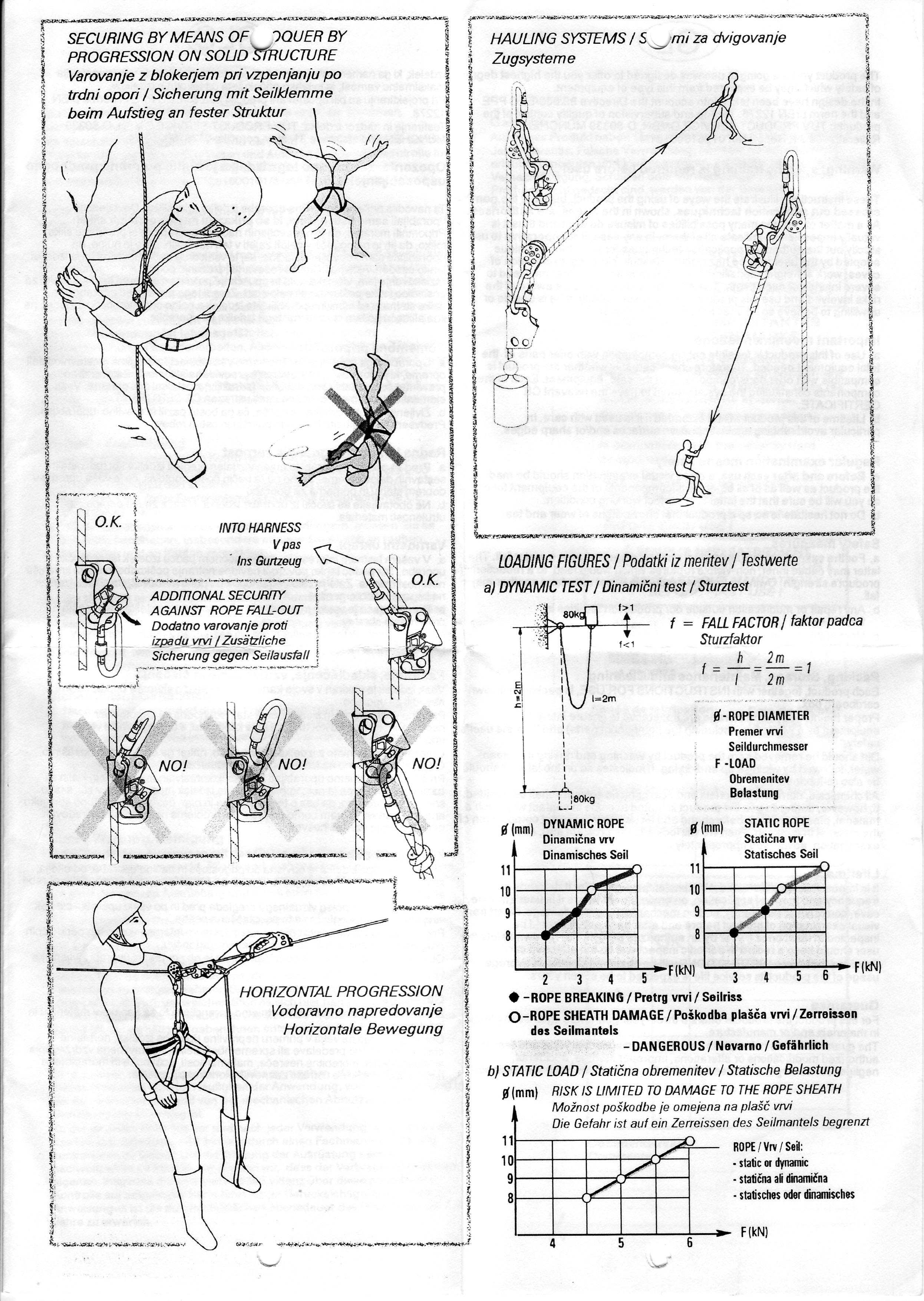Technical Details
I acquired this pair of ascenders from Inner Mountain Outfitters
in August 1999.
The VauDe AB-20 Bloquer is 108 mm. tall, 76 mm. wide, 30 mm. thick, and weighs 153 g.
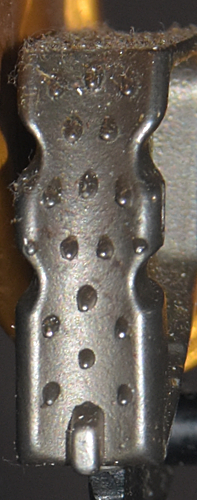 The shell is a tall irregular shaped stamping made from 4.2 mm. aluminum alloy sheet metal. The stamping has one reinforcing
rib behind the cam. The ascender is right-handed, as are similar
ascenders made by others. A 15 mm. rope channel is formed in the left
side and a smaller cam channel lies to the right. A hole drilled
through both sides of the cam channel accepts a 5 mm. roll
rivet. The rivet is centered 49 mm. from the inside of the rope channel. The cam and cam spring are mounted on this rivet. A 15.8 mm.
sling attachment hole is punched below the cam, and a novel slot
extends from the hole. This design facilitates sewing the ascender
to webbing, or allows the more traditional carabiner attachment.
A second, 13 mm. hole is also provided at the bottom. A 14.9
by 20.9 mm. oval hole through both sides of the rope channel
provide an attachment point just above the cam, and a 15.0 mm.
hole is punched through the rear of the shell beside it. There
is no cam stop.
The shell is a tall irregular shaped stamping made from 4.2 mm. aluminum alloy sheet metal. The stamping has one reinforcing
rib behind the cam. The ascender is right-handed, as are similar
ascenders made by others. A 15 mm. rope channel is formed in the left
side and a smaller cam channel lies to the right. A hole drilled
through both sides of the cam channel accepts a 5 mm. roll
rivet. The rivet is centered 49 mm. from the inside of the rope channel. The cam and cam spring are mounted on this rivet. A 15.8 mm.
sling attachment hole is punched below the cam, and a novel slot
extends from the hole. This design facilitates sewing the ascender
to webbing, or allows the more traditional carabiner attachment.
A second, 13 mm. hole is also provided at the bottom. A 14.9
by 20.9 mm. oval hole through both sides of the rope channel
provide an attachment point just above the cam, and a 15.0 mm.
hole is punched through the rear of the shell beside it. There
is no cam stop.
The cam is a plated skeletonized steel casting. The cam radius increases from 38 to 52 mm. over an angle of 39°, giving a 24° cam angle. The cam has
number of small conical teeth, all of which have their axes approximately
in line with the corresponding radius from the cam pivot. The
tooth pattern is (3.2)^2(1.2)^2(B) pattern, where "B"
indicates a bar. There are two notches on each side of the cam
face, presumable for mud relief. Unlike some other ascenders,
the inner cam face radius appears to be constant. A spring-loaded
manual safety bar is mounted on the bottom of the cam with a small
semi-tubular rivet. The normal action of the spring holds the safety against
the cam. When the cam is opened, the shell interferes with the
safety bar, thus preventing opening the cam. If the safety bar
is moved away from the cam (opposing the spring), it will clear
the shell and the cam will open. At full open the safety can be
released and the spring will hold the safety against the back
of the shell. This provides a means of locking the cam open. A
pin on the safety assists in operating the safety mechanism.
The front of the ascender has a "AB-20," a triangle and double arrow logo, "ROPES" and "ø8-13 mm"
stamped on the rope channel. The rear is stamped with "CE0123,"
"VauDe" and a three-leaf logo. "0399-A" is
stamped behind the cam.
The following ascenders are all variations of the same basic design, made by the same company under three different names:
| Image
| Ascender
| Shell Finish
| Top Hole(s) | Bottom Hole(s)
| Cam Stop
|
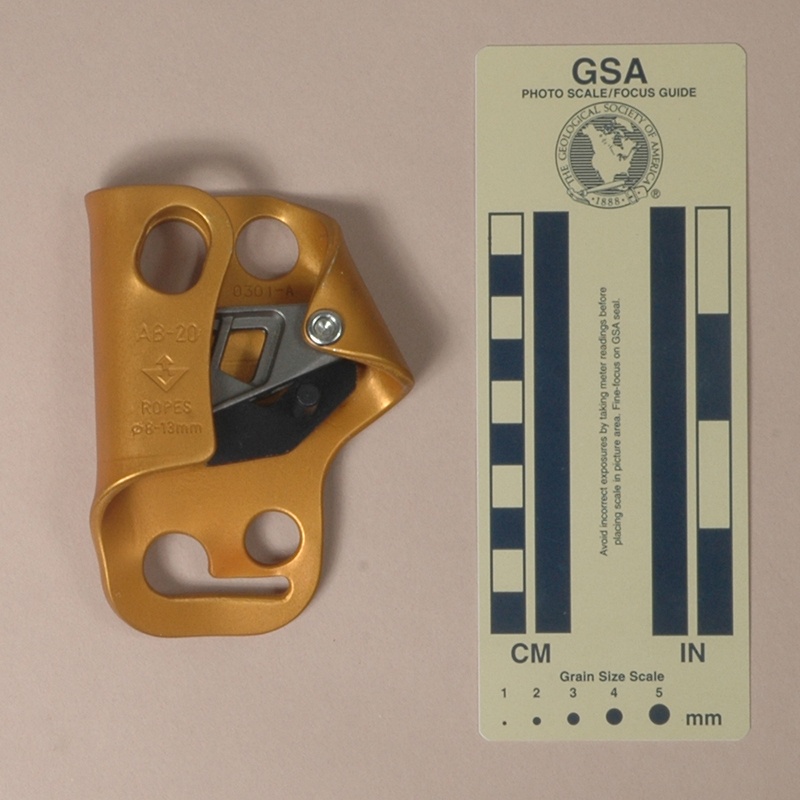 |
Anthron AB-20, Version A |
Anodized |
Two carabiner-size |
Two carabiner-size
(one with webbing slot) |
None |
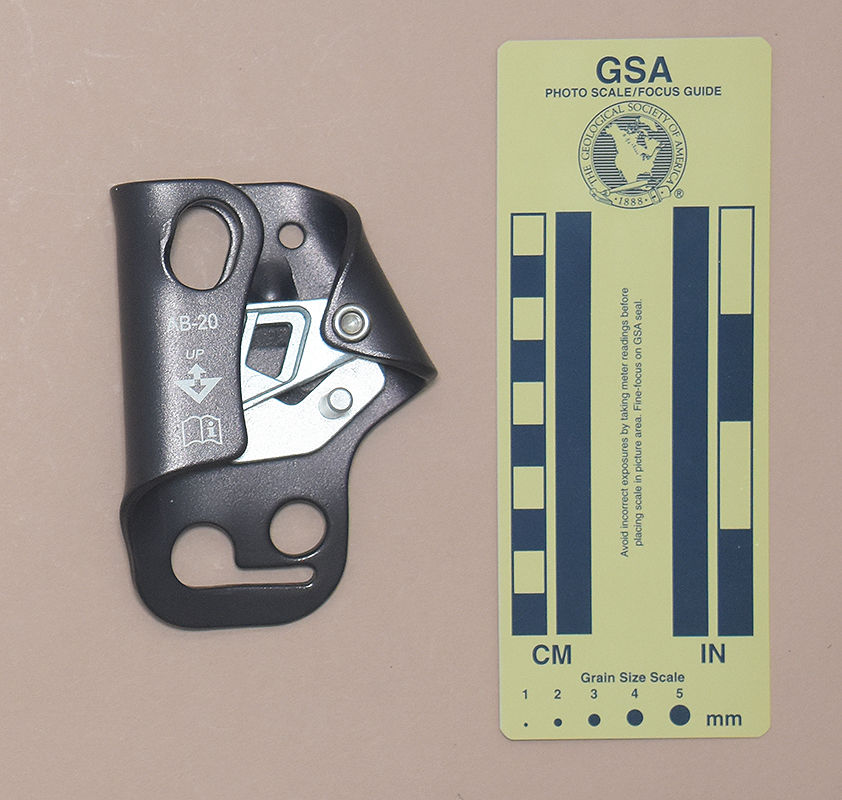 |
Anthron AB-20, Version B |
Anodized |
One carabiner-size, one small |
Two carabiner-size
(one with webbing slot) |
Stamped |
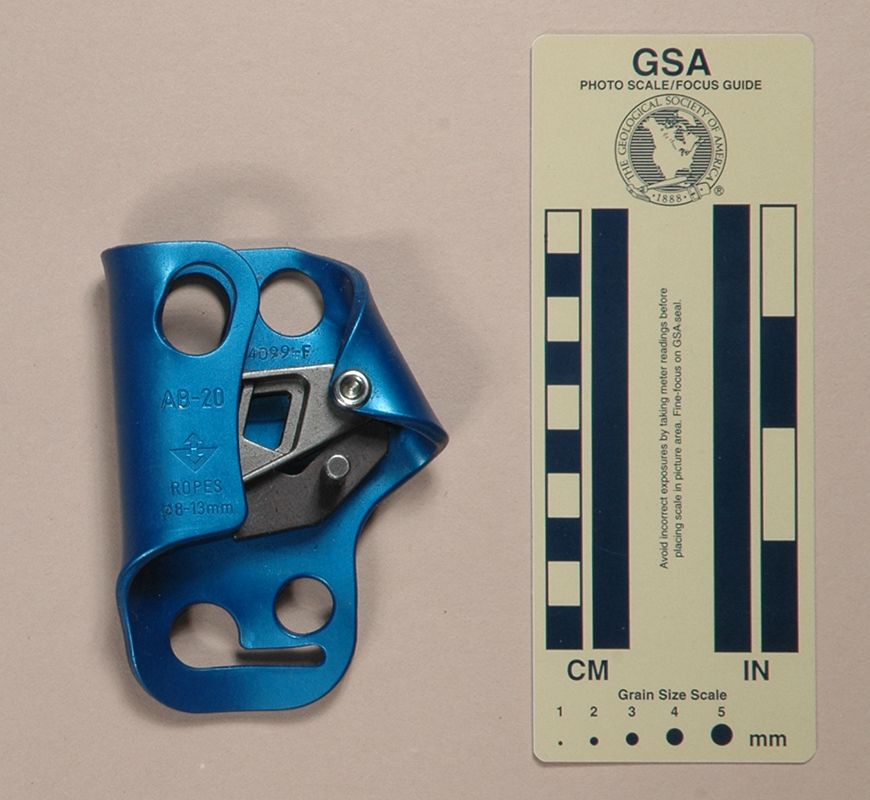 |
Lucky AB-20 |
Anodized |
Two carabiner-size |
Two carabiner-size
(one with webbing slot) |
None |
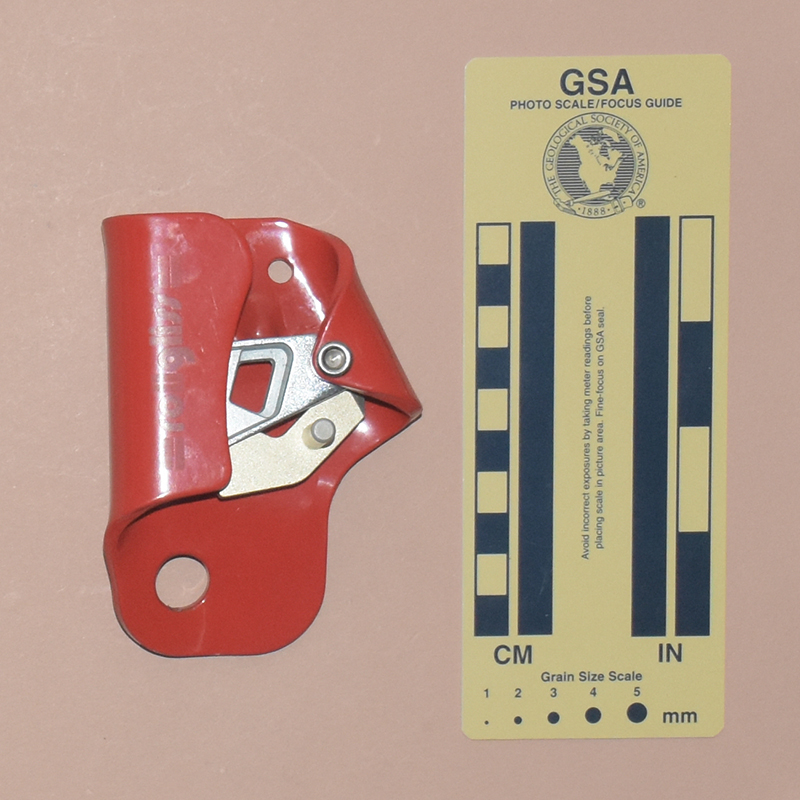 |
Rollgliss R250 |
Painted |
One small |
One carabiner-size |
Stamped |
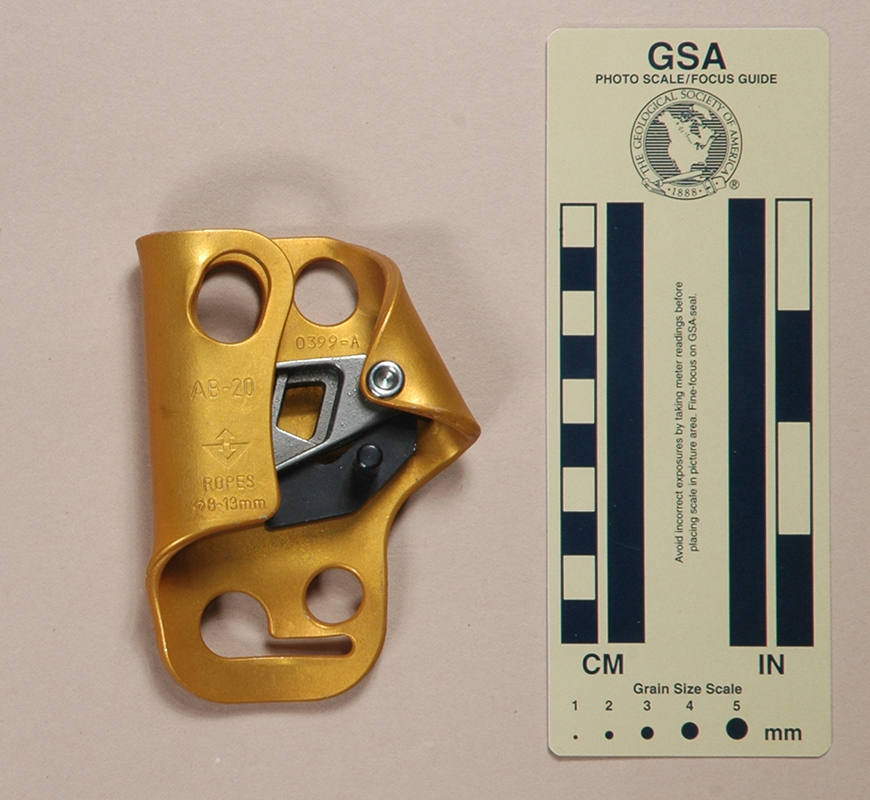 |
VauDe AB-20 |
Anodized |
Two carabiner-size |
Two carabiner-size
(one with webbing slot) |
None |
|
The Anthron AB-20, Version B differs from the others by having a stamped cam stop and a smaller secondary top hole. The Rollgliss R250 uses the same shell and cam as the Anthron AB-20, Version B (including the cam stop), but has fewer attachment holes, making it slightly heavier and less versatile.
These are well-made ascenders and perform much like the Petzl Basic. All sharp edges have been removed.
The cam teeth are very well done. The attachment points are simply
holes in the shell, and although rounded they should have been
beveled more; even so, I would consider their small radius too
sharp for directly attaching rope slings. They are acceptably
rounded for webbing, and the unique slot on those that have it makes it easy to sew
webbing (up to 35 mm.) in place. Considering the proximity
of the attachment points to the main rope, I would recommend using
a small maillon for most rope attachments in order to reduce the
risk of sling abrasion.
The upper rope attachment hole through the rope channel is located
very close to the main rope . A carabiner through the upper attachment hole will probably drag on the main line. Note that such a carabiner
will prevent putting the ascender on or off rope, so one's climbing system must be designed accordingly.
The safety is awkward to use with one hand (like the Petzl
Basic). The cam is very well made. The notches don't seem
to provide much help in muddy conditions - but nobody else's similar
ascender works well either. I'm not sure what purpose the bar
serves - several people have sent me emails telling me that the
bar keeps the cam from closing and touching the shell. I agree,
it does, but so what? Putting the ascender on rope does the same
thing. Initially I wondered if the bar would interfere with using
the ascender. It does not appear that it will, at least on 9 mm
and larger ropes.



